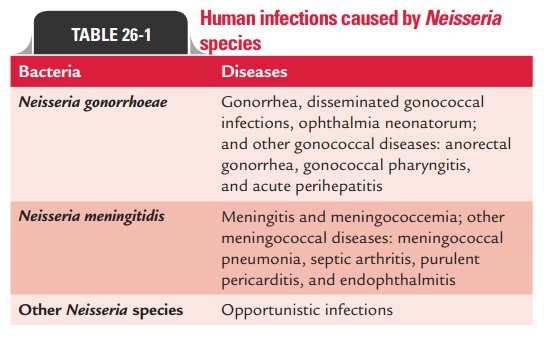Chapter: Microbiology and Immunology: Bacteriology: Neisseria
Neisseria gonorrhoeae
Neisseria
Introduction
The genus Neisseria consists of Gram-negative, aerobic, nonsporing, nonmotile cocci, typically arranged in pairs (diplococci) with adjacent sides flattened together. The bacteria belonging to this genus are oxidase positive and mostly catalase positive. They ferment sugars with production of acid but no gas.
The genus Neisseria consists of 10 species. Neisseria gonorrhoeae and Neisseria meningitidis are the two important species that cause human infections. These two species are strictly pathogens for humans, whereas the other Neisseria species are commensals of the mouth and upper respiratory tract, and hence cause oppor-tunistic infections. Human infections caused by Neisseria are listed in Table 26-1.

Neisseria gonorrhoeae
N. gonorrhoeae is a strict human pathogen. It is the causativeagent of gonorrhea, one of the most common sexually trans-mitted disease worldwide. Gonococci when transmitted non-sexually from the mother’s genital tract to the newborn during birth cause ophthalmia neonatorum.
Properties of the Bacteria
◗ Morphology
N.gonorrhoeae shows following features:
· N. gonorrhoeae are Gram-negative and aerobic diplococci.They are mostly intracellular—found within the polymor-phonuclear (PMN) leukocytes—and some cells contain as many as hundred cocci. Smears from the pus sample show the intracellular kidney-shaped cocci, typically arranged in pairs with concave sides facing each other.
· Freshly isolated bacteria may be capsulated. They do not form endospores.
· They are nonmotile.
◗ Culture
N. gonorrhoeae is a fastidious coccus. It requires complex mediafor growth. The cocci grow on enriched media, such as blood or chocolate agar. These cannot grow on ordinary media, such as nutrient agar or Mueller–Hinton agar. They are aerobes but can also grow anaerobically. They grow optimally at a temperature range of 35–36°C. They fail to grow at temperature less than 25°C or greater than 37°C. The growth of bacteria is enhanced by incubation in humid atmosphere supplemented with 5–10% CO2.
1. Blood agar: On blood agar at 24 hours, N. gonorrhoeaeproduces convex small colonies measuring 0.6 3 1.4 mmin diameter. These colonies are translucent with entireedges and finely granular surface. They are soft and eas-ily emulsifiable. Gonococci are inhibited by fatty acidsand trace metals present in the digested products of pep-tone found in the blood agar. Addition of soluble starchto the media neutralizes the toxic effects of the fattyacids.
2. Selective media: Thayer Martin medium (chocolate agar medium containing antibiotics, such as colistin,nystatin, and vancomycin) and modified New York City medium (a translucent medium containing vancomycin,colistin, trimethoprim, and either nystatin or amphoteri-cin B) are selective media used for isolation of gonococci rom the clinical specimens containing mixed micro- eisseria gonorrhoeae Neisseria meningitidis Human infections caused by Neisseria species Diseases Gonorrhea, disseminated gonococcal infections, ophthalmia neonatorum; and other gonococcal diseases: anorectal gonorrhea, gonococcal pharyngitis, and acute perihepatitis Meningitis and meningococcemia; other meningococcal diseases: meningococcal pneumonia, septic arthritis, purulent pericarditis, and endophthalmitis bial flora. In these media, the growth of contaminat- ng bacteria is suppressed including that of commensal Neisseria. On these media, N. gonorrhoeae produces smal translucent, and convex colonies, which are softof colonies of gonococci have been recognized.
· These are T1, T2, T3, and T4.
· Types 1 and 2 are small and are brown pigmented colo- nies. The strains producing these colonies possess pili, are virulent and cause acute cases of gonorrhea.
· Types 3 and 4 are large and are nonpigmented colonies. The cocci producing these colonies do not possess pili and are avirulent.
3.Transport medium: Stuart’s transport medium is usedfor the collection and transport of clinical specimens to the laboratory for isolation and demonstration of N. gonorrhoeae.
◗ Biochemical reactions
gonorrhoeae shows following features:
· Gonococci ferment glucose with the production of acid but no gas.
· They do not ferment maltose, lactose, sucrose, or fructose. This is an important feature to differentiate N. gonorrhoeae from N. meningitidis. N. gonorrhoeae utilizes glucose only, whereas N. meningitidis utilizes both glucose and maltose.
· They do not reduce nitrates, and they do not produce hydrogen sulfide.
· They are oxidase and catalase positive.
◗ Other properties
Susceptibility to physical and chemical agents: Thegonococci are highly delicate bacteria. They die rapidly on drying. They are also killed by soap, and many other disinfec-tants, such as phenol, chlorhexidine, and hexachlorophene and antiseptics. They are killed at a temperature as low as 25°C. Freeze drying or storing in liquid nitrogen are the most effec-tive methods for storage of gonococci for a longer period.
Related Topics